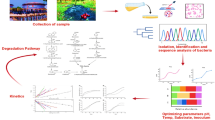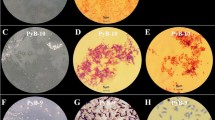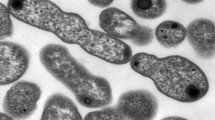Abstract
A high-efficiency fluoranthene-degrading bacterium Paenibacillus sp. PRNK-6 was isolated from PAH-contaminated soil. The strain degrades 96% (240 mg l−1) of fluoranthene in 48 h. Various metabolic intermediates of fluoranthene catabolism were identified by gas chromatography (GC) and gas chromatography–high resolution mass spectrometry (GC-HRMS). Metabolite characterization, metabolite-feeding experiments, and appropriate enzyme activities in the cell-free extracts suggest the existence of a bifurcated pathway down the phthalic acid for complete mineralization of fluoranthene in PRNK-6. In this strain, fluoranthene catabolism begins by the attack on the fused aromatic ring portion of fluoranthene. Two terminal aromatic metabolites protocatechuate and catechol undergo ring cleavage by protocatechuate 3,4-dioxygenase and catechol 1,2-dioxygenase, respectively, and enter the central metabolism.




Similar content being viewed by others
Abbreviations
- PAHs:
-
Polycyclic aromatic hydrocarbons
- LMW:
-
Low molecular weight PAHs
- HMW:
-
High molecular weight PAHs
- US-EPA:
-
United States Environmental Protection Agency
- MSTFA:
-
N-Methyl-N- (trimethylsilyl)trifluoroacetamide
- TMS:
-
Trimethyl silane
- MSM:
-
Mineral salt medium
- GC:
-
Gas chromatography
- GC-HRMS:
-
Gas chromatography–high resolution mass spectrometry
- BLAST:
-
Basic Local Alignment Search Tool
- NCBI:
-
National Center for Biotechnology Information
References
Aftring RP, Taylor BF (1981) Aerobic and anaerobic catabolism of phthalic acid by a nitrate-respiring bacterium. Arch Microbiol 130:101–104
AL-Saleh E, Obuekwe C (2014) Crude oil biodegradation activity in potable water. Int Biodeterior Biodegrad 93:18–24
Bertani G (1951) Studies on lysogenesis. I. The mode of phage liberation by lysogenic Escherichia coli. J Bacteriol 62:293–300
Blumer M (1976) Polycyclic aromatic compounds in nature. Sci Am 234:35–45
Crawford RL (1975) Degradation of 3-hydroxybenzoate by bacteria of the genus Bacillus. Appl Microbiol 30:439–444
Crawford RL (1976) Pathways of 4-hydroxybenzoate degradation among species of Bacillus. J Bacteriol 127:204–210
Desai AM, Autenrieth RL, Dimitriou-Christidis P, McDonald TJ (2008) Biodegradation kinetics of select polycyclic aromatic hydrocarbon (PAH) mixtures by Sphingomonas paucimobilis EPA505. Biodegradation 19:223–233
Eaton RW, Ribbons DW (1982) Metabolism of dibutylphthalate and phthalate by Micrococcus sp. strain 12B. J Bacteriol 151:48–57
Ebenau-Jehle C, Mergelsberg M, Fischer S (2017) An unusual strategy for the anoxic biodegradation of phthalate. ISME J 11:224–236
El Bour M, Dellali M, Aissa P, Duran R (2008) Characterization of aerobic polycyclic aromatic hydrocarbon-degrading bacteria from Bizerte lagoon sediments. Tunisia. 104:987–997
Folwell BD, McGenity TJ, Whitby C (2016) Characterisation of biofilm and planktonic bacterial and fungal communities transforming high molecular weight polycyclic aromatic hydrocarbons. Appl Environ Microbiol 82:2288–2299 (AEM.03713-15)
Gladen BC, Zadorozhnaja TD, Chislovska N et al (2000) Polycyclic aromatic hydrocarbons in placenta. Hum Exp Toxicol 19:597–603
Gordon L, Dobson ADW (2001) Fluoranthene degradation in Pseudomonas alcaligenes PA-10. Biodegradation 12:393–400
Guo C, Dang Z, Wong Y, Tam NF (2010) Biodegradation ability and dioxgenase genes of PAH-degrading Sphingomonas and Mycobacterium strains isolated from mangrove sediments. Int Biodeterior Biodegrad 64:419–426
Hara H, Eltis LD, Davies JE, Mohn WW (2007) Transcriptomic analysis reveals a bifurcated terephthalate degradation pathway in Rhodococcus sp. strain RHA1. J Bacteriol 189:1641–1647
Haritash AK, Kaushik CP (2009) Biodegradation aspects of Polycyclic Aromatic Hydrocarbons (PAHs): a review. J Hazard Mater 169:1–15
Hegeman GD (1966) Synthesis of the enzymes of the mandelate pathway by Pseudomonas putida synthesis of enzymes by the wild type. J Bacteriol 91:1140–1154
Heitkamp MA, Franklin W, Cerniglia CE (1988) Microbial metabolism of polycyclic aromatic hydrocarbons: isolation and characterization of a pyrene-degrading bacterium. Appl Environ Microbiol 54:2549–2555
Hentati D, Chebbi A, Loukil S et al (2016) Biodegradation of fluoranthene by a newly isolated strain of Bacillus stratosphericus from Mediterranean seawater of the Sfax fishing harbour, Tunisia. Environ Sci Pollut Res 23:15088–15100
Hilyard EJ, Jones-Meehan JM, Spargo BJ, Hill RT (2008) Enrichment, isolation, and phylogenetic identification of polycyclic aromatic hydrocarbon-degrading bacteria from Elizabeth River sediments. Appl Environ Microbiol 74:1176–1182
Ho Y, Jackson M, Yang Y et al (2000) Characterization of fluoranthene- and pyrene-degrading bacteria isolated from PAH-contaminated soils and sediments. J Ind Microbiol Biotechnol 24:100–112
IARC (2010) IARC monographs on the evaluation of carcinogenic risks to humans: some non-heterocyclic polycyclic aromatic hydrocarbons and some related exposures. Iarc Monogr Eval Carcinog Risks Humans 92:1–868
Isaac P, Martínez FL, Bourguignon N et al (2015) Improved PAHs removal performance by a defined bacterial consortium of indigenous Pseudomonas and actinobacteria from Patagonia, Argentina. Int Biodeterior Biodegrad 101:23–31
Ito Y (2003) Effects of fluoranthene, a polycyclic aromatic hydrocarbon, on cAMP-dependent anion secretion in human airway Epithelia. J Pharmacol Exp Ther 308:651–657
Iwabuchi T, Harayama S (1997) Biochemical and genetic characterization of 2-carboxybenzaldehyde dehydrogenase, an enzyme involved in phenanthrene degradation by Nocardioides sp. strain KP7. J Bacteriol 179:6488–6494
Jacob J, Karcher W, Belliardo JJ, Wagstaffe PJ (1986) Polycyclic aromatic compounds of environmental and occupational importance. Fresenius’ Zeitschrift für Anal Chemie 323:1–10
Juhasz AL, Stanley GA, Britz ML (2000) Microbial degradation and detoxification of high molecular weight polycyclic aromatic hydrocarbons by Stenotrophomonas maltophilia strain VUN 10,003. Lett Appl Microbiol 30:396–401
Kelley I, Freeman JP, Evans FE, Cerniglia CE (1993) Identification of metabolites from the degradation of fluoranthene by Mycobacterium sp. strain PYR-1. Appl Environ Microbiol 59:800–806
Kumar S, Upadhayay SK, Kumari B et al (2011) In vitro degradation of fluoranthene by bacteria isolated from petroleum sludge. Bioresour Technol 102:3709–3715
Kweon O, Kim SJ, Jones RC et al (2007) A polyomic approach to elucidate the fluoranthene-degradative pathway in Mycobacterium vanbaalenii PYR-1. J Bacteriol 189:4635–4647
López Z, Vila J, Minguillón C, Grifoll M (2006) Metabolism of fluoranthene by Mycobacterium sp. strain AP1. Appl Microbiol Biotechnol 70:747–756
Lowry OH, Rosebrough NJ, Farr AL, Randall RJ (1951) Protein measurement with the Folin phenol reagent. J Biol Chem 1:193–265
Ma J, Xu L, Jia L (2013) Characterization of pyrene degradation by Pseudomonas sp. strain Jpyr-1 isolated from active sewage sludge. Bioresour Technol 140:15–21
Macdonald DL, Stanier RY (1954) The enzymatic formation of β-carboxymuconic acid. J Biol Chem 210:809–820
McNamee G, Don R (1985) Properties of a membrane-associated from Rhodotorula Clyde graminis. Biochem Biophys Res Commun 129:485–492 (Durham of Microbial Biochemistry Genex Corporation MD 20877 Membrane zoate in matography activi)
Nayak AS, Sanjeev Kumar S, Santosh Kumar M et al (2011) A catabolic pathway for the degradation of chrysene by Pseudoxanthomonas sp. PNK-04. FEMS Microbiol Lett 320:128–134
Pepi M, Lobianco A, Renzi M et al (2009) Two naphthalene degrading bacteria belonging to the genera Paenibacillus and Pseudomonas isolated from a highly polluted lagoon perform different sensitivities to the organic and heavy metal contaminants. Extremophiles 13:839–848
Qi J, Wang B, Li J et al (2015) Genetic determinants involved in the biodegradation of naphthalene and phenanthrene in Pseudomonas aeruginosa PAO1. Environ Sci Pollut Res 22:6743–6755
Rehmann K, Hertkorn N, Kettrup AA (2001) Fluoranthene metabolism in Mycobacterium sp. strain KR20: identity of pathway intermediates during degradation and growth. Microbiology 147:2783–2794
Saunders CR, Shockley DC, Knuckles ME (2003) Fluoranthene-induced neurobehavioral toxicity in F-344 rats. Int J Toxicol 22:263–276
Schagger H, Cramer WA, Vonjagow G et al (2004) Taxonomic outline of the prokaryotes. In: Bergey’s manual of systematic bacteriology, vol 217, pp 1–399
Schippers A, Bosecker K, Spröer C, Schumann P (2005) Microbacterium oleivorans sp. nov. and Microbacterium hydrocarbonoxydans sp. nov., novel crude-oil-degrading Gram-positive bacteria. Int J Syst Evol Microbiol 55:655–660
Selck H, Palmqvist A, Forbes VE (2003) Biotransformation of dissolved and sediment-bound fluoranthene in the polychaete, Capitella sp. I. Environ Toxicol Chem 22:2364–2374
Šepič E, Bricelj M, Leskovšek H (1998) Degradation of fluoranthene by Pasteurella sp. IFA and Mycobacterium sp. PYR-1: isolation and identification of metabolites. J Appl Microbiol 85:746–754
Sheng XF, He LY, Zhou L, Shen YY (2009) Characterization of Microbacterium sp. F10a and its role in polycyclic aromatic hydrocarbon removal in low-temperature soil. Can J Microbiol 55:529–535
Story SP, Parker SH, Hayasaka SS et al (2001) Convergent and divergent points in catabolic pathways involved in utilization of fluoranthene, naphthalene, anthracene, and phenanthrene by Sphingomonas paucimobilis var. EPA505. J Ind Microbiol Biotechnol 26:369–382
Tamura K, Stecher G, Peterson D et al (2013) MEGA6: molecular evolutionary genetics analysis version 6.0. Mol Biol Evol 30:2725–2729
Trenz SP, Engesser KH, Fischer P, Knackmuss HJ (1994) Degradation of fluorene by Brevibacterium sp. strain DPO 1361: a novel C–C bond cleavage mechanism via 1,10-dihydro-1,10-dihydroxyfluoren-9-one. J Bacteriol 176:789–795
Van Herwijnen R, Van De Sande BF, Van Der Wielen FWM et al (2003) Influence of phenanthrene and fluoranthene on the degradation of fluorene and glucose by Sphingomonas sp. strain LB126 in chemostat cultures. FEMS Microbiol Ecol 46:105–111
Weissenfels WD, Beyer M, Klein J (1990) Degradation of phenanthrene, fluorene and fluoranthene by pure bacterial cultures. Appl Microbiol Biotechnol 32:479–484
Yamaguchi K, Near R, Shneider A et al (1996) Fluoranthene-Induced Apoptosis in Murine T Cell Hybridomas Is Independent of the Aromatic Hydrocarbon Receptor1. Toxicol Appl Pharmacol 139:144–152
Yuan SY, Chang JS, Yen JH, Chang BV (2001) Biodegradation of phenanthrene in river sediment. Chemosphere 43:273–278
Zhang H, Kallimanis A, Koukkou AI, Drainas C (2004) Isolation and characterization of novel bacteria degrading polycyclic aromatic hydrocarbons from polluted Greek soils. Appl Microbiol Biotechnol 65:124–131
Zhang Z, Hou Z, Yang C et al (2011) Degradation of n-alkanes and polycyclic aromatic hydrocarbons in petroleum by a newly isolated Pseudomonas aeruginosa DQ8. Bioresour Technol 102:4111–4116
Zhong Y, Luan T, Wang X et al (2007) Influence of growth medium on cometabolic degradation of polycyclic aromatic hydrocarbons by Sphingomonas sp. strain PheB4. Appl Microbiol Biotechnol 75:175–186
Zhong Y, Luan T, Lin L et al (2011) Production of metabolites in the biodegradation of phenanthrene, fluoranthene and pyrene by the mixed culture of Mycobacterium sp. and Sphingomonas sp. Bioresour Technol 102:2965–2972
Zhu X, Jin L, Sun K et al (2016) Potential of endophytic bacterium Paenibacillus sp. PHE-3 isolated from plantago asiatica L. for reduction of PAH contamination in plant tissues. Int J Environ Res Public Health 13:633
Zielinska-Park J, Nakamura J, Swenberg JA, Aitken MD (2004) Aldehydic DNA lesions in calf thymus DNA and HeLa S3 cells produced by bacterial quinone metabolites of fluoranthene and pyrene. Carcinogenesis 25:1727–1733
Acknowledgements
The authors wish to thank SAIF, Indian Institute of Technology Bombay, Powai, Mumbai, India, for the analysis of fluoranthene metabolites by GC-HRMS and the University Grants Commission (UGC), New Delhi, India, for financial support in the form of UGC-SAP programme [No. F. 4-27/2015/DRS-II (SAP-II)] sanctioned to the department. One of the authors, Pooja V. Reddy, acknowledges the UGC, New Delhi, for financial assistance through UGC-BSR Fellowship.
Author information
Authors and Affiliations
Corresponding author
Ethics declarations
Conflict of interest
The authors declare that they have no conflict of interest.
Additional information
Communicated by Matthias Boll.
Electronic supplementary material
Below is the link to the electronic supplementary material.
Rights and permissions
About this article
Cite this article
Reddy, P.V., Karegoudar, T.B., Monisha, T. et al. Biodegradation of fluoranthene by Paenibacillus sp. strain PRNK-6: a pathway for complete mineralization. Arch Microbiol 200, 171–182 (2018). https://doi.org/10.1007/s00203-017-1431-9
Received:
Revised:
Accepted:
Published:
Issue Date:
DOI: https://doi.org/10.1007/s00203-017-1431-9




